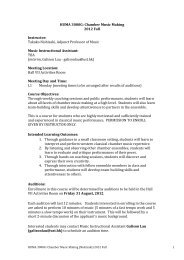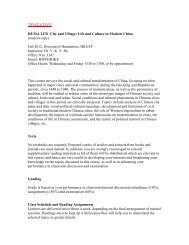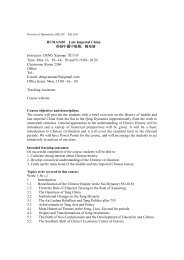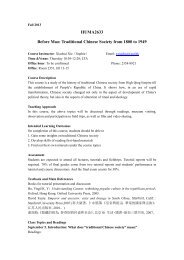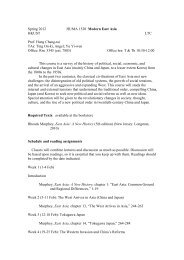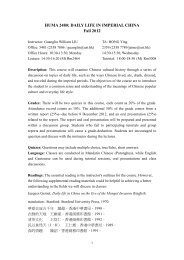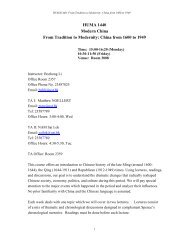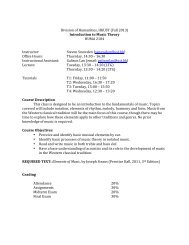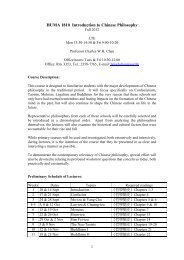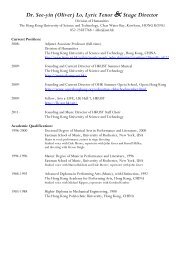HUMA 1152 Introduction to Photography
HUMA 1152 Introduction to Photography
HUMA 1152 Introduction to Photography
- No tags were found...
You also want an ePaper? Increase the reach of your titles
YUMPU automatically turns print PDFs into web optimized ePapers that Google loves.
Fall 2011 – 2012<strong>HUMA</strong> <strong>1152</strong> <strong>Introduction</strong> <strong>to</strong> Pho<strong>to</strong>graphyCourse Instruc<strong>to</strong>r:Instructional Assistant:TSE Ming Chong(Rm 4596, Tel: 2358-5855; Email: tsemingchong@ust.hk)Arion LAM(Rm 4596, Tel: 2358-8373; Email: arionlam@ust.hk)Time & Venue: Section 1L1: Tuesday, 09:00-10:50; Rm 3584 (L27-28)LA1: Thursday, 09:00-11:50; LTG (L25-26)Section 2L2: Tuesday, 15:00-16:50; Rm 3501 (L25-26)LA2: Thursday, 15:00-17:50; Rm 4620 (L31-32)Office Hours:Tuesday and Thursday, 13:30-14:30, and by appointmentCourse DescriptionAn introduction <strong>to</strong> the art and expression of pho<strong>to</strong>graphy through lectures, hands-on activities and fieldtrip. In this course, students will learn about the his<strong>to</strong>ry and development of pho<strong>to</strong>graphy,pho<strong>to</strong>graphers who have helped shape our vision of the world and the great pho<strong>to</strong>graphs they havemade, basic pho<strong>to</strong>graphic vocabularies, perspectives, concepts, theories and techniques and mostimportantly, pho<strong>to</strong>graphy as a documentary, communication and expressive medium. Upon thecompletion of this course, students will also have a much deeper understanding of the power andbreadth of pho<strong>to</strong>graphy through studying how it affected and reflected the societal and cultural changesin societies.Intended Learning OutcomesUpon completion of this course, students are expected <strong>to</strong> be able <strong>to</strong>:1. describe and appreciate the his<strong>to</strong>ry and development of pho<strong>to</strong>graphy;2. communicate the characteristics of contemporary art pho<strong>to</strong>graphy and appreciate the master works;3. explain basic concepts, theories and techniques of pho<strong>to</strong>graphy;4. analyze and explain the relationship between pho<strong>to</strong>graphy and society by understanding themeanings behind different pho<strong>to</strong>graphic images;5. use pho<strong>to</strong> as documentary <strong>to</strong>ol <strong>to</strong> record facts and explore ideas; and6. use pho<strong>to</strong> as a medium of expression and communication.1
Syllabus and ScheduleWeek 1 (Sep 1)Course <strong>Introduction</strong>Brief His<strong>to</strong>ry of Pho<strong>to</strong>graphy and its Development- The nature of a pho<strong>to</strong>graph: as artistic expression, document, commercial promotion or journalisticcommunication.Reading pho<strong>to</strong>graphs- Subject, object, pho<strong>to</strong>graphers’ intentions, viewers’ expectations and background, and context- Perspectives for considering pho<strong>to</strong>graphy: cultural, his<strong>to</strong>rical, aesthetic, technical and criticalExercise 1: “Writing on Pho<strong>to</strong>s”- Reflecting on Images exercise <strong>to</strong> analyze pho<strong>to</strong>sReading:Miller, Denise, Pho<strong>to</strong>grapher’s multiple roles: art, document, market, science, Museum ofContemporary Pho<strong>to</strong>graphy, p11-51.Week 2 (Sep 6, 8)LecturePho<strong>to</strong>graphic attributes- Camera operation- Relationship between shutter speed, lens and apertureLabExercise 2: Make 5 pho<strong>to</strong>s that can demonstrate different ISO, shutter speed, focal length, aperture,depth of field and point of view. (outside classroom at UST)Reading:Roland Barthes, The Pho<strong>to</strong>graphy Reader, Liz Wells ed., Routledge, p.19-30.Week 3 (Sep 13, 15)Outing: 13/09/2011 7pm – 10 pm Causeway Bay Mid-autumn festival shooting.LabCritique on Exercise 2Reading:Michael Freeman, The Pho<strong>to</strong>grapher’s Eye: Composition and Design for Better Digital Pho<strong>to</strong>s, FocalPress, 2007.2
Week 4 (Sep 20, 22)LectureComposition and Color- Composition rules and guidelines- Color: color temperature management (i.e. indoor Vs outdoor) and cus<strong>to</strong>m white balance.LabExercise 3: Use different light condition <strong>to</strong> make pho<strong>to</strong>sReading:Michael Freeman, The Pho<strong>to</strong>grapher’s Eye: Composition and Design for Better Digital Pho<strong>to</strong>s, FocalPress, 2007.Week 5 (Sep 27, 29)No class, make up class on 23/10/2011 field trip.Week 6 (Oct 4, 6)LecturePho<strong>to</strong>graphy and Society- Study how pho<strong>to</strong>graphy affected and reflected the cultural changes in societies or even the politicalpolicies (i.e. the pho<strong>to</strong> on child labor which affected the US Government policy in 1920s-30s)LabStudents’ presentations on chosen pho<strong>to</strong>graphers & pho<strong>to</strong> under different light conditions.Reading:Ian Jeffrey, Pho<strong>to</strong>graphy – A concise his<strong>to</strong>ry, Thames and Hudson, p.178-203Week 7 (Oct 11, 13)LecturePho<strong>to</strong>graphy as Documentary Tool- To study how pho<strong>to</strong>graphy can be used as a <strong>to</strong>ol <strong>to</strong> document and investigate cultural and socialissues. Concepts and techniques behind will be discussed.Assignment 1: Pho<strong>to</strong> as documentary <strong>to</strong>olLabExercise 4: Fieldtrip <strong>to</strong> the city and take 5-8 pho<strong>to</strong>s that reflect the cultural or social issues of HK (i.e.poverty, women movement, environment issues, heritage etc.)Reading:Miller Denise, Pho<strong>to</strong>grapher’s multiple roles: art, document, market, science, Museum ofContemporary Pho<strong>to</strong>graphy, p84-118.3
LabExercise 5: Making a pho<strong>to</strong> collagePresentation and critiqueReading:David Hockney, Hockney on pho<strong>to</strong>graphy: conversations with Paul Joyce, New York: HarmonyBooks, c1988. P30-52.Week 12 (Nov 15, 17)Lecture<strong>Introduction</strong> <strong>to</strong> Portrait Pho<strong>to</strong>graphy- Concepts, techniques and master works on portrait and self portraitBriefing on Final Individual ProjectAssignment 2: make a portrait and a self portraitLabExercise 6: Make a self portraitWeek 13 (Nov 22, 24)Lecture<strong>Introduction</strong> <strong>to</strong> Contemporary Hong Kong Art Pho<strong>to</strong>graphy- Background, selected pho<strong>to</strong>graphers and their works in cultural and his<strong>to</strong>rical contextLabCritique on Assignment 2Final Individual Project Tu<strong>to</strong>rialReading:City Flâneur: Social Documentary Pho<strong>to</strong>graphy, Hong Kong Heritage Museum, 2010.Week 14 (Nov 29, Dec 1)LectureSet Up and Preparation for ExhibitionLabFinal Project Presentation & Critique IWeek 15 (Dec 6)Final Project Presentation & Critique II and Course Summary5
Assessment TasksAttendanceAttendance will be taken 10 minutes after the beginning of each session after the add-drop period. Foreach absence, students will have 1% deducted from their attendance grade (10% maximum deduction).Class ParticipationStudents are evaluated based on their participation and critiques on in-class exercises.Assignment 1Pho<strong>to</strong>graphy as documentary <strong>to</strong>ol.i/ A 500-word essay on the his<strong>to</strong>ry and development of documentary pho<strong>to</strong>graphy, as well as therelationship between pho<strong>to</strong>graphy and society is required.ii./ Each student has <strong>to</strong> take three <strong>to</strong> five pho<strong>to</strong>s which document a social or cultural issue of HK.Pho<strong>to</strong> texts are required for complimentary purpose.Assignment 2Pho<strong>to</strong>graphy as self-expression <strong>to</strong>ol.i/ A 500-word essay on a subject related <strong>to</strong> the concepts and theories of contemporary pho<strong>to</strong>graphy isrequired.ii/ Each student has <strong>to</strong> take a portrait and a self portrait. Pho<strong>to</strong> texts are required for complimentarypurpose.Final Projecti/ Art work: Twelve 8R pho<strong>to</strong>s on either a documentary <strong>to</strong>pic on a social or cultural issue of HK or aself-expression <strong>to</strong>picii/ A 800-word written report discussing the themes, concepts and theories applied on the art work isrequired. What students learned from the project should be mentioned as well.iii/ Art work presentation and exhibition in week 14Visual DiaryA visual log book which record the creative process of studentsGrading1. Attendance 10%2. Class Participation 10%3. Assignment 1 15%4. Assignment 2 15%5. Final Project 30%6. Visual Diary 20%(Specific marking criteria for assessment tasks no. 3 <strong>to</strong> 6 will be explained <strong>to</strong> students before each task begins)6
The letter grades grading system will be used based on University Guidelines:A (10-20% of the class)B (25-40% of the class)C (35-45% of the class)D (5-10% of the class)F (0-5%)Required Reading Materials1. Miller, Denise, Pho<strong>to</strong>grapher’s multiple roles: art, document, market, science, Museum ofContemporary Pho<strong>to</strong>graphy, p11-51.2. Roland Barthes, The Pho<strong>to</strong>graphy Reader, Liz Wells ed., Routledge, p.19-30.3. Michael Freeman, The Pho<strong>to</strong>grapher’s Eye: Composition and Design for Better Digital Pho<strong>to</strong>s,Focal Press, 2007.4. Ian Jeffrey, Pho<strong>to</strong>graphy – A concise his<strong>to</strong>ry, Thames and Hudson, p.178-2035. Miller Denise, Pho<strong>to</strong>grapher’s multiple roles: art, document, market, science, Museum ofContemporary Pho<strong>to</strong>graphy, p84-118.6. Pho<strong>to</strong>graphy & Writing, Focus on Pho<strong>to</strong>graphy: A Curriculum Guide, International Center ofPho<strong>to</strong>graphy, 2006, p71-94. (Online resource)7. Charlotte Cot<strong>to</strong>n, The Pho<strong>to</strong>graph as Contemporary Art, Thames & Hudson, 2004.8. David Hockney, Hockney on pho<strong>to</strong>graphy: conversations with Paul Joyce, New York: HarmonyBooks, c1988. P30-52.9. City Flâneur: Social Documentary Pho<strong>to</strong>graphy, Hong Kong Heritage Museum, 2010.Supplementary Reading Materials1. Angela Faris Belt, The Elements of Pho<strong>to</strong>graphy: Understanding and Creating SophisticatedImages, Focal Press, 2008.2. Robert Hirsch, Pho<strong>to</strong>graphic Possibilities: The Expressive Use of Equipment, Ideas, Materials andProcesses, 3 rd Edition, Focal Press, 2008.3. Eugenia Parry & Naomi Rosenblum, Pho<strong>to</strong>graphy's Multiple Roles, D.A.P./The Museum ofContemporary Pho<strong>to</strong>graphy, 1998.4. Liz Wells, The Pho<strong>to</strong>graphy Reader, Routledge, 2002.5. Terry Barrett, Criticizing Pho<strong>to</strong>graphs: An <strong>Introduction</strong> <strong>to</strong> Understanding Images, McGraw-HillHumanities/Social Sciences/Languages, 4 th Edition, 2005.6. Roland Barthes, Camera Lucida: Reflections on Pho<strong>to</strong>graphy, Hill and Wang; 2nd Edition, 1982.7. Barbara London & John Up<strong>to</strong>n, Pho<strong>to</strong>graphy, Prentice Hall, 10 th Edition, 2010.8. J. Jeffrey, Pho<strong>to</strong>graphy: A Concise His<strong>to</strong>ry (World of Art), Thames & Hudson, 1989.9. Ken Light, Witness in Our Time: Working Lives of Documentary Pho<strong>to</strong>graphers, SmithsonianBooks, 2 nd Edition, 2010.7



